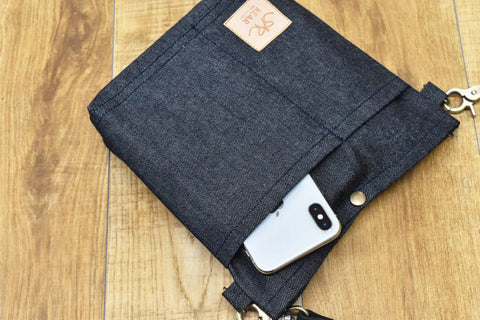
[Precautions before using denim products] Prevent denim color transfer

Hello! We are the working team of Hallelujah.
This time, I tried to tone down the Okayama denim shoulder bag I introduced in the previous article!
I'll explain the origins of Okayama denim, why denim fades, and what you should do to minimize fading in the first place.
Hope you will like it! 😊
What is Okayama denim?

First of all, what is "Okayama denim"?
Okayama denim refers to denim produced in the Ihara (near Ihara City) and Kojima (Kurashiki City) areas of Okayama Prefecture. Sometimes called Ihara denim and Kojima denim. It uses natural dyes to dye indigo denim. The technique of deliberately leaving the center part undyed during the dyeing process is called "core white" and is highly praised at home and abroad. Nearly all the processes required to make denim, including spinning (converting fibers into thread), dyeing, weaving and processing, are done in this region. "Okayama Denim" truly adheres to the spirit of Japanese craftsmanship and is produced by craftsmen with high technical standards and quality control.
Indigo dye

"Indigo dyeing" is a dyeing process that uses the "indigo" component in plants, while the often heard "indigo dyeing" refers to the dyeing process using chemical dyes. "Indigo dyeing" is challenging because it uses natural plants and requires highly technical skills to achieve stable dyeing. However, despite the use of natural indigo dye, Okayama denim maintains stable dyeing and quality, which is why the brand is highly praised. Although indigo-dyed denim does not fade easily, a slight blue tint may transfer when rubbed against light or wet items.
All of Hallelujah's denim products use Okayama denim, so issues like this may arise when using these products. So before using denim products, in order to minimize fading. We're going to introduce a method for lightening and preventing fading that you can easily do at home! 😊
Fading condition
First before fading, we tested how faded it would be in its new state without any treatment.

First we wiped it with a dry cloth 30 times!
Some fading has appeared 🧐

Next, we used a damp cloth and wiped it 30 times.
Getting very blue! ! Even if wiped with a dry cloth, it will turn slightly blue, and with a damp cloth, it will turn very blue.
To reduce this fading to some extent, we will perform a "fading".
Lightening <br>The main purpose is to achieve a certain level of lightening before wearing indigo or dyed denim,
To prevent fading from affecting other clothing or sneakers.
So let’s get started!

Waterproof Spray/Salt/Vinegar/Laundry Detergent <br>These are the things you need.
These are all things you probably already have at home or have easy access to!

Waterproof spray:
After soaking the fabric in water and diluting it, use a waterproof spray to prevent the leather label from turning blue.
Soak in salt water:
Soak the fabric in salt water before diluting. You may be wondering, salt? But the salt is said to have the property of sealing the dye used in denim into the fiber and fixing it.

Soak in salt water:
For 1 liter of water, add a tablespoon of salt. Keep soaking and let sit for 1 hour. After an hour, drain the water. It is worth noting that if the soaking time exceeds 1 hour, the metal hooks and belt loops may be corroded by the salt, so please stick to the time.
Soak in vinegar water:
After soaking in salt water, soak it in water mixed with vinegar. The laundry detergent used in the following steps is alkaline, which removes grease and dirt from denim. The grease content has disappeared, so vinegar, which is acidic, is used to neutralize the alkalinity.

Again for 1 liter of water, add a tablespoon of vinegar. Soak again for 1 hour. After an hour, drain the water.
Removing the Adhesive Next, in order to maintain the tension of the denim, we will remove the adhesive soaked in it. Add laundry detergent to warm water and soak for 1 hour.

The amount of laundry used depends on the need. No need to add much.
30 minutes later...

Stickers appear and water becomes cloudy 😳
After one hour...

More adhesive comes to the surface than before. Now that 1 hour has passed, it's time to rinse.
wipe and clean
First drain the dirty hot water, then rinse the detergent and surfacing adhesive from the denim.

Accumulate water, wipe, drain water. We repeat this process 3 times.

water after washing.
As the number of repetitions increases, the color change becomes lighter🧐
dry
After cleaning, let it dry naturally.

Unfortunately, the weather was bad that day, so I had to dry it indoors 🥺
When placed under a heater, it dries surprisingly quickly, in a fairly short amount of time!

Appearance after drying. Due to the good texture of the original fabric, there is little deformation.
Even after removing the adhesive, the texture remains tight ☺️
We wiped the body so this time let’s check the color transfer after fading 🧐

Just like in the beginning, we wiped it with a dry cloth 30 times. Surprisingly! Even though the fabric is white, it barely turns blue. The fade effect worked! Also we tried wiping with a damp cloth. Although there's a slight fade compared to the beginning, there's still quite a bit of blue. Therefore I believe it will be difficult to avoid color transfer when wiping with wet items.
Finally, based on the results of this experiment, we found that fading treatment can prevent color transfer to a certain extent! Additionally, after doing some research I discovered that using a waterproofing spray before wearing can make the fabric resistant to moisture. This increases the durability of the garment even in light rain or when you sweat in the summer.
There are two ways to use waterproof spray:
"Use before each outing" and "Spray and dry before sunny weather."
So please choose the appropriate spraying frequency according to your usage😊
While color transfer has been reduced, it has not been completely eliminated.
Use extreme caution if worn with white or light-colored clothing.
Thank you for reading till the end 😌
See you next time 🥰



